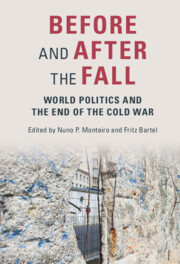Book contents
- Before and After the Fall
- Before and After the Fall
- Copyright page
- Dedication
- Epigraph
- Contents
- Figures
- Tables
- Contributors
- Preface
- Introduction
- Part I Sources of Continuity and Change
- Part II Continuity and Change Across the 1989/1991 Divide
- Part III Toward a New World Order?
- 12 Great Powers and the Spread of Autocracy Since the Cold War
- 13 Seeds of Failure
- 14 The United States and NATO After the End of the Cold War
- 15 The Historical Legacy of 1989
- 16 Requiem for a Cold War
- 17 After Primacy
- 18 World Order across the End of the Cold War
- Index
18 - World Order across the End of the Cold War
from Part III - Toward a New World Order?
Published online by Cambridge University Press: 02 December 2021
- Before and After the Fall
- Before and After the Fall
- Copyright page
- Dedication
- Epigraph
- Contents
- Figures
- Tables
- Contributors
- Preface
- Introduction
- Part I Sources of Continuity and Change
- Part II Continuity and Change Across the 1989/1991 Divide
- Part III Toward a New World Order?
- 12 Great Powers and the Spread of Autocracy Since the Cold War
- 13 Seeds of Failure
- 14 The United States and NATO After the End of the Cold War
- 15 The Historical Legacy of 1989
- 16 Requiem for a Cold War
- 17 After Primacy
- 18 World Order across the End of the Cold War
- Index
Summary
What are the essential features of the post-Cold War world order and how is it likely to evolve? In this chapter, Nuno P. Monteiro analyzes the magnitude of the power shifts that took place around the 1989/91 watershed – between the United States and both Russia and China – and examines the ways in which the post-Cold War order relates to earlier times. Much has changed on the surface, above all the emergence of a preponderant global power, the United States. At the same time, much has also remained the same: the centrality of states, their goals and strategies, the role of material capabilities and ideology in furthering state goals, the effects of the nuclear revolution, and so on. Combining these continuities and changes, Monteiro distills the central features of world order in the post-Cold War era. He then concludes by looking at current transformations in world politics – such as the emergence of a viable alternative to the Western way of life backed by the massive capabilities of the Chinese state – and highlighting the major issues on which the future of world order hangs.
Keywords
- Type
- Chapter
- Information
- Before and After the FallWorld Politics and the End of the Cold War, pp. 338 - 360Publisher: Cambridge University PressPrint publication year: 2021
- 1
- Cited by

